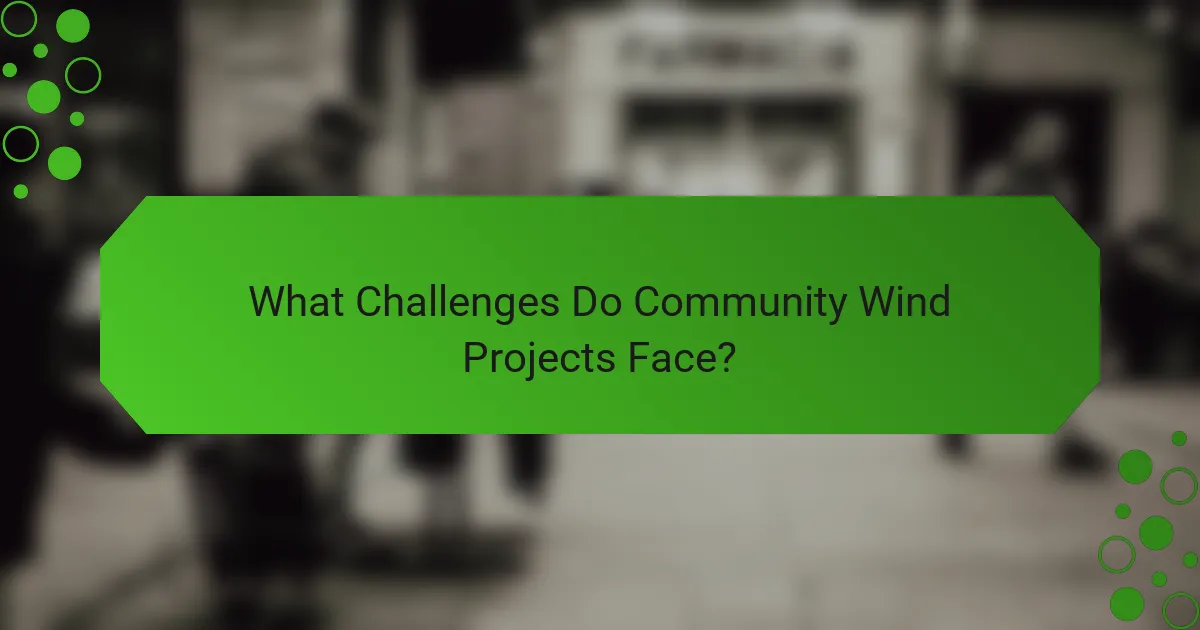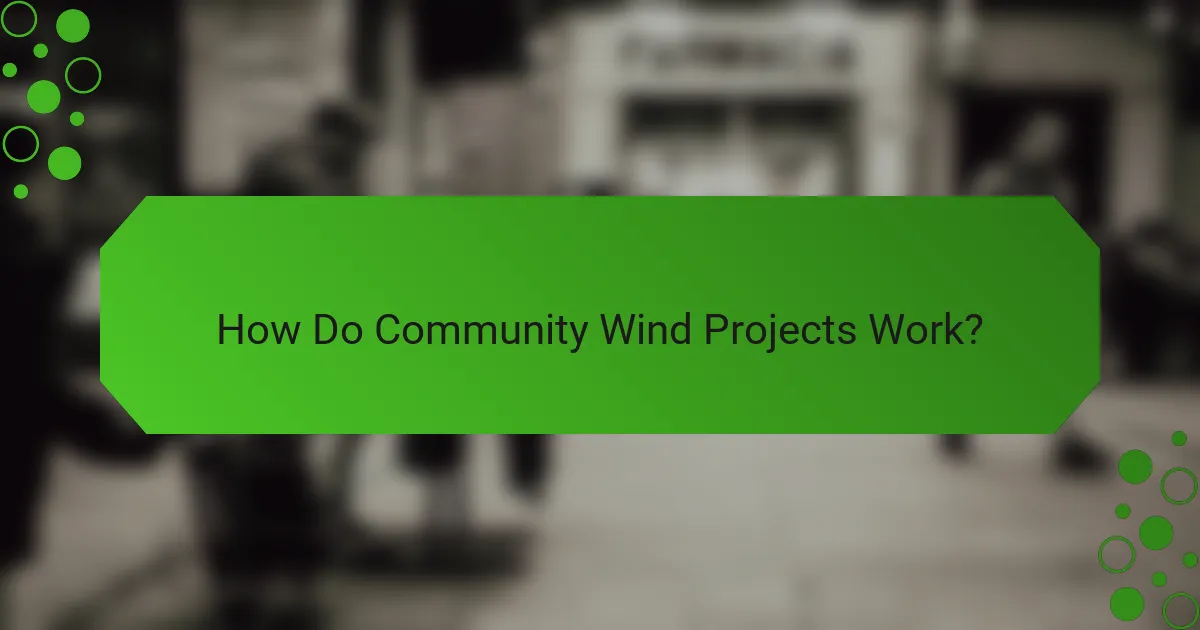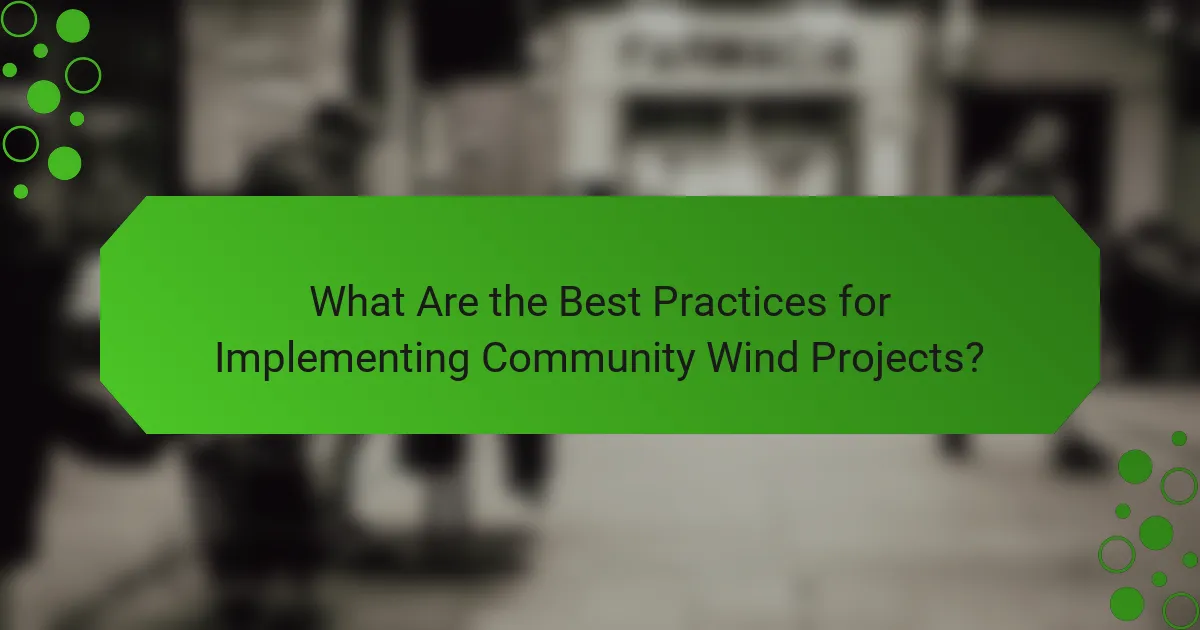Community wind projects represent a collaborative effort among local stakeholders to harness wind energy, offering significant benefits such as reduced energy costs, job creation, and enhanced sustainability. However, these initiatives also face challenges, including regulatory hurdles and community opposition, which can impact their development. By navigating these complexities, communities can achieve long-term energy independence and economic growth through renewable energy solutions.

What Are the Benefits of Community Wind Projects?
Community wind projects offer numerous advantages, including reduced energy costs, local job creation, and enhanced environmental sustainability. These initiatives empower communities by involving them in energy production and fostering long-term energy independence.
Cost savings on energy
Community wind projects can significantly lower energy costs for local residents and businesses. By generating electricity locally, communities can reduce reliance on expensive grid power and avoid transmission losses. Many projects report savings of 10-30% on energy bills, depending on the scale and efficiency of the wind turbines.
Additionally, surplus energy can be sold back to the grid, providing further financial benefits to the community. This creates a sustainable revenue stream that can support local initiatives and infrastructure improvements.
Job creation in local areas
Implementing community wind projects creates jobs in various sectors, including construction, maintenance, and operations. These projects often require skilled labor, providing employment opportunities for local workers and boosting the economy. Job creation can range from a handful of positions in small projects to hundreds in larger initiatives.
Moreover, local businesses benefit from increased economic activity, as workers and contractors purchase goods and services in the area. This ripple effect can lead to long-term economic growth and stability.
Environmental sustainability
Community wind projects contribute to environmental sustainability by reducing greenhouse gas emissions and reliance on fossil fuels. Wind energy is a clean, renewable resource that helps combat climate change and improve air quality. By investing in wind power, communities can significantly decrease their carbon footprint.
Furthermore, these projects often incorporate sustainable practices, such as land preservation and habitat protection, enhancing local ecosystems. The shift towards renewable energy sources is crucial for achieving national and global sustainability goals.
Community engagement and empowerment
Community wind projects foster engagement by involving residents in the decision-making process. This participation empowers individuals to take ownership of their energy future, enhancing community cohesion and pride. When locals are involved, projects are more likely to reflect the needs and values of the community.
Additionally, educational initiatives related to wind energy can increase awareness and understanding of renewable resources, encouraging further participation in sustainability efforts. This collective engagement can lead to stronger advocacy for local environmental policies.
Long-term energy independence
By developing community wind projects, areas can achieve greater energy independence, reducing vulnerability to external energy market fluctuations. This independence allows communities to stabilize energy prices and enhance their resilience against supply disruptions.
Investing in local wind energy also supports energy diversification, making it easier for communities to transition to a more sustainable energy future. Over time, this can lead to significant reductions in energy costs and increased energy security for residents and businesses alike.

What Challenges Do Community Wind Projects Face?
Community wind projects encounter several challenges that can hinder their development and success. Key issues include regulatory hurdles, funding difficulties, community opposition, and technical logistics that must be navigated effectively.
Regulatory hurdles
Regulatory hurdles are significant obstacles for community wind projects, often involving complex permitting processes and compliance with local, state, and federal regulations. Each jurisdiction may have different requirements, which can lead to delays and increased costs.
To mitigate these challenges, project developers should engage with regulatory agencies early in the planning process. Understanding local zoning laws and environmental regulations can streamline approvals and reduce the risk of project setbacks.
Funding and financing issues
Securing funding for community wind projects can be challenging due to the high upfront costs associated with wind energy infrastructure. Many projects rely on a mix of private investment, grants, and government incentives, which can vary widely by location.
Developers should explore diverse financing options, including community investment models, which allow local residents to buy shares in the project. This approach not only raises capital but also fosters local support and engagement.
Community opposition and NIMBYism
Community opposition, often referred to as NIMBYism (Not In My Back Yard), can significantly impact the feasibility of wind projects. Residents may express concerns about noise, visual impact, and potential effects on local wildlife.
To address these concerns, project developers should prioritize transparent communication and community engagement. Hosting informational meetings and providing clear data on environmental impacts can help build trust and alleviate fears.
Technical and logistical challenges
Technical and logistical challenges include site selection, turbine installation, and maintenance. Finding suitable locations that meet wind resource requirements while minimizing environmental impact can be complex.
Developers should conduct thorough site assessments and feasibility studies to identify optimal locations. Additionally, planning for logistics, such as transportation of large turbine components, is crucial to avoid delays and cost overruns during construction.

How Do Community Wind Projects Work?
Community wind projects involve local stakeholders collaborating to develop and manage wind energy installations. These initiatives typically focus on harnessing wind resources to generate renewable energy while providing economic benefits to the community.
Project development process
The project development process for community wind projects generally includes several key stages: site assessment, feasibility studies, permitting, financing, and construction. Initially, developers assess wind resources and site suitability, often using wind measurement equipment to gather data over a year or more.
Once a suitable site is identified, feasibility studies evaluate the project’s technical and economic viability. This includes estimating energy production, costs, and potential returns. After securing necessary permits, which can vary by region, the project moves into financing and construction phases, where local engagement is crucial for success.
Stakeholder involvement
Stakeholder involvement is essential in community wind projects, as it ensures that local interests are represented. Key stakeholders typically include local residents, government agencies, environmental groups, and investors. Engaging these parties early in the process fosters transparency and builds trust, which can mitigate opposition.
Community meetings and informational sessions can help address concerns and gather feedback. Additionally, forming a local advisory board can facilitate ongoing communication and collaboration throughout the project’s lifecycle.
Financing models
Financing models for community wind projects can vary widely, but common approaches include community ownership, cooperative models, and third-party financing. Community ownership allows local residents to invest directly in the project, sharing in both the risks and rewards.
Cooperatives can pool resources from multiple members, making it easier to fund larger projects. Alternatively, third-party financing involves external investors who provide capital in exchange for a share of the revenue, which can reduce the financial burden on the community while still allowing local benefits.

What Are Successful Case Studies of Community Wind Projects?
Successful case studies of community wind projects demonstrate how local involvement can lead to sustainable energy solutions. These projects not only provide renewable energy but also foster community engagement and economic benefits.
Example: The Blue Sky Wind Project
The Blue Sky Wind Project, located in Colorado, showcases how community investment can drive renewable energy initiatives. This project involved local stakeholders who contributed to funding and decision-making, resulting in a wind farm that generates clean energy for the region.
Key considerations included ensuring community buy-in and navigating local regulations. The project successfully created jobs and provided a steady revenue stream for local governments, illustrating the economic advantages of community involvement.
Example: The Community Wind Farm in Minnesota
The Community Wind Farm in Minnesota is a prime example of a cooperative model where local residents own a portion of the wind turbines. This project emphasizes shared ownership, allowing community members to benefit directly from the energy produced.
By pooling resources, the community was able to finance the project without relying heavily on external investors. This model not only reduced costs but also strengthened local ties, as residents were directly invested in the success of the wind farm.
Example: The Cape Cod Wind Project
The Cape Cod Wind Project, proposed off the coast of Massachusetts, aimed to harness wind energy while addressing environmental concerns. Although it faced regulatory challenges and community opposition, it highlighted the importance of stakeholder engagement in project planning.
Lessons learned from this project include the need for transparent communication with local communities and addressing environmental impacts. Successful wind projects often require balancing economic benefits with ecological considerations to gain public support.

What Are the Best Practices for Implementing Community Wind Projects?
Implementing community wind projects effectively requires a strategic approach that emphasizes local involvement and clear communication. Best practices include engaging stakeholders early, ensuring transparency, and adapting to community needs throughout the project lifecycle.
Community engagement strategies
Community engagement is crucial for the success of wind projects. Effective strategies involve identifying key stakeholders, such as local residents, businesses, and government entities, and actively involving them in the planning and decision-making processes. This can be achieved through public meetings, surveys, and workshops that encourage open dialogue.
Building trust is essential. Regular updates on project developments and addressing community concerns promptly can foster a positive relationship. Utilizing social media and local newsletters can help keep the community informed and engaged, ensuring that their voices are heard and valued.
Consider establishing a community advisory board to facilitate ongoing communication and feedback. This board can represent diverse community interests and provide insights that help shape the project to better align with local values and priorities.
